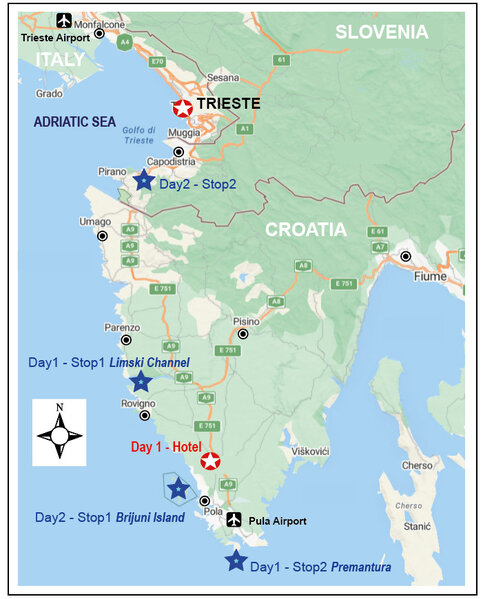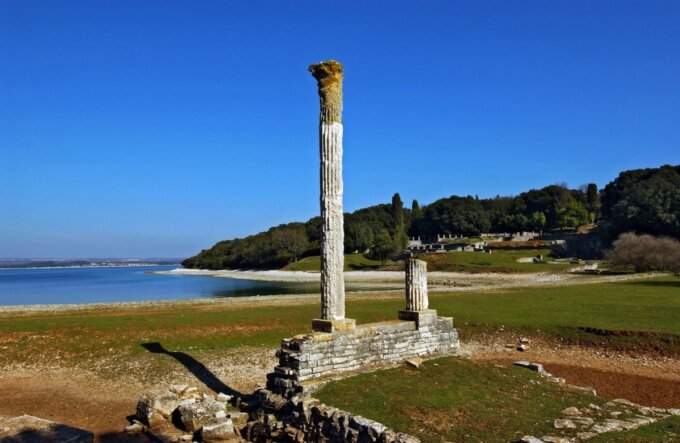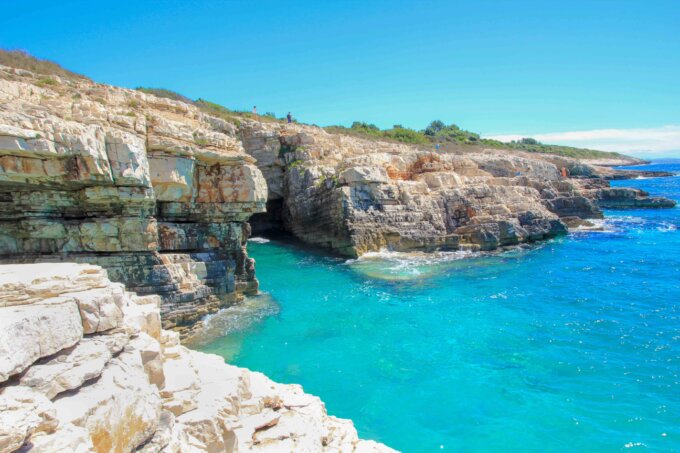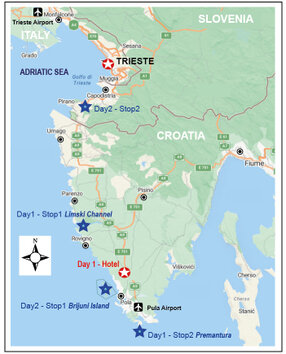Post-conference field trip
Istrian rocky coasts: coastal landforms in the northeastern Adriatic Sea
Duration: 2 days, 1 night (27 June 2025)
Participant number: 30
Participation fee includes: transportation, accommodation, coffee breaks, entrance fees.
Final costs: 250 €
Description:
The field trip will be focused on the Istrian coasts, from Trieste (Italy) to Premantura (Croatia), in the northeastern Adriatic Sea. Coastal landforms have been deeply studied in Istria, both as present-day processes and also considering their Quaternary evolution. Several approaches, such as 3D modelling, sea level change reconstruction, wave action models, archaeological human-made remains etc, were used to study and model Istrian rocky coasts. From Trieste to Slovenia, the coast is made of flysch shore platforms that are now almost entirely man-made. From Savudrija (Croatia) limestone dominates down to south Adriatic Sea. A well-carved submerged notch has been widely studied by several authors. This relict notch, together with pools, pinnacles, sea caves, sea stacks, etc. are part of the local coastal scenery. In the southernmost sector of the Istrian peninsula, Kamenijak, a wide deposit of storm wave boulders has been recently studied. This coastal accumulation testify that in a relatively sheltered context such as the Istrian peninsula, large boulders can be moved by extreme waves. At Briunj island, a small archipelago with many Roman Age emerged and submerged archaeological remains, several micro erosion meter stations have been set and measured since 2003. They allowed to evaluate limestone lowering rates at different wave exposure.
For those who wish, it will be possible to take a short swim in Premantura, including inside a small sea cave. It is recommended to bring a mask.

Field-trip Itinerary and program
• 08:00 AM – Departure from Trieste, Piazza Oberdan
Meeting with the group and departure by coach towards Croatia.
• 10:00 AM – FIRST STOP: Limski Channel
Arrival and boat tour through the picturesque Limski Channel
• 12:00 PM – Lunch Break
Lunch at a local restaurant or packed lunch (not included).
• 1:30 PM – Departure for Premantura
Journey to the southern tip of the Istrian Peninsula.
• 3:00 PM – SECOND STOP: Premantura peninsula
Visit to the natural area of Premantura, including a walk through Kamenjak Nature Park to the southernmost point of the peninsula.
• 6:00 PM – Departure for Fažana
Return north with evening arrival at Fažana.
• 7:00 PM – Arrival at the Hotel Letan (Fažana)
Dinner at the hotel restaurant
Second Day
• 8:30 AM – Departure from the Hotel
• 9:00 AM – Departure for Brijuni
• 10:00 AM – FIRST STOP: Brijuni
Visit to the rocky coasts of Brijuni and its coastal archaeological sites.
• 1:00 PM – Lunch Break
Lunch at a local restaurant or packed lunch, depending on the organization (not included in the fee).
• 2:00 PM – SECOND STOP: Brijuni
Visit to Brijuni island
• 4:00 PM – Departure from Brijuni
• 7:00 PM – Arrival in Trieste, Piazza Oberdan


